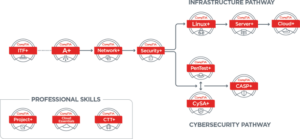This post is written by NCCER, a Platinum Level sponsor of the 2019 Advance CTE Spring Meeting.
Somewhere along the way, we have lost sight of what the American Dream is. We’ve begun equating success with a career path only achieved through a four-year academic degree or higher.
Our workforce has suffered from this mentality of only valuing the so-called “white-collar” professionals in our economy. We are facing workforce shortages of skilled workers that will only increase as seasoned Baby Boomers retire.
What can we do to change this? One key to transforming our workforce development system is these three numbers: One. Two. Seven.

Only one job out of ten requires a master’s degree or higher. Two out of ten need a bachelor’s degree. And the remaining seven? These only need an associate degree, certification, craft training or credential.
Our current perception of what a successful career is only focused on 30 percent of jobs. Skilled professions, those that call for certifications, credentials, on-the-job training, often face three misconceptions: They are not lucrative. They are low or middle-skilled. They are dead-end jobs.
Let’s bust these three common misconceptions, particularly in the construction field.
 1. Not lucrative.
1. Not lucrative.
A popular misconception is that “most well-paying jobs require (at least) a college degree, and getting one of those requires a significant portion of young people to essentially forego owning their own home (part of the much venerated ‘American Dream’) for years and years.” In fact, well-paying jobs are readily available and don’t require sacrificing the typical physical representations of success. Cameron Campbell, millwright, and Josh Chavers, welder, share how they’ve been able to afford brand-new trucks, homes and vacations because of the opportunities they’ve found.
Often overlooked, the construction industry provides sustainable and lucrative careers, like Cameron and Josh’s. CareerBuilder and Indeed both listed construction positions as some of the best jobs to get ahead in 2018. The industry is estimated to need 1.4 million skilled craft professionals by 2022, and with 41 percent of the current construction workforce set to retire by 2031, opportunities are only growing.
In fact, multiple careers in construction make a national average salary (without overtime, per diem or incentives) over $65,000 and do not require a four-year degree: boilermaker, mobile crane operator, millwright, industrial electrician, and welder, just to name a few.
2. Low or middle-skilled.
Forty-six percent of U.S. employers are having a difficult time hiring because they can’t find the skills they actually need in the workforce.
Despite offering great salaries, many of the most in-demand jobs are not only ignored but rarely shared as viable options or are only presented as ‘if you can’t succeed in the academic world’ jobs. These careers are made fun of in TV shows — remember the SNL skit poking fun at project managers? Or construction workers only shown as digging ditches? They paint a picture of jobs that people only pick when they can’t find anything else. But let’s take a minute to consider the skills a career — and not just a job — in construction really entails.
Pipefitters calculate as many, if not more, mathematical equations in a typical workday than an engineer. Welders have to make sure their welds can hold up beams that support tons of weight — and I literally mean tons as a measurement and not figuratively. Electricians have to understand complicated systems and electrical components, as well as stay up-to-date on national, state and local codes.
Blue-collar and white-collar careers remain pitted against one another, and a path toward a blue-collar career is undoubtedly portrayed as the less desirable choice. If you have ever tried to construct, install or repair any number of complicated projects in or on your own home, you know that highly trained professionals are anything but replaceable. Instead, they are essential to the longevity and functionality of the places that mean the most to us. These misguided terms used to describe craft professionals fail to represent the rigorous training, credentials, professionalism and strong work ethic belonging to the individual underneath the hard hat. By referring to them as anything other than highly skilled professionals, we are ultimately devaluing the work they do and decreasing the appeal of entering these careers.
3. Dead-end jobs.
Performance-driven jobs put workers in charge of their career progression. A career as a craft professional has a lot of potential — to advance from entry level to fully trained to seasoned craft professional can take eight to 12 years, and leadership positions are entirely achievable, from management to CEO.
In fact, management jobs in the construction industry are going to be impacted even more severely by the Baby Boomers retiring, leaving the door wide open for craft professionals to expand their careers — 67 percent of the seasoned construction management is due to retire by 2031. Because construction is mostly performance-driven, you are the determining factor in how far you climb the ladder of success.
Boyd Worsham is a great example: Boyd started as an apprentice directly out of high school, worked his way up to become a journeyman carpenter, foreman, assistant superintendent, superintendent and finally the vice president of construction support for The Haskell Company and is now the president of an international education foundation, NCCER.
Ultimately, what do we want for our children and students? Do we want them to only focus on achieving an academic degree or would we rather see them find success on a path they may not have considered? Regardless if a four-year degree is required, we should want the next generation to find satisfaction, happiness and success in their field.
And construction workers are happy. The 2015 Best Industry Ranking Report published by TINYpulse surveyed more than 500 organizations and over 30,000 employees across 12 distinct industries and found that construction workers are the happiest employees.
Why wouldn’t they be? With lucrative careers and growth opportunities, craft professionals are not only successful but have pride in their chosen path. The world as we know it, from our hospitals and roads to our schools and houses, would not exist without the expertise of craft professionals. Let’s not discount career paths just because it may not fit our misguided idea of success, but rather rediscover the American Dream and encourage all options to be explored.


 Success after high school looks different for everyone. Increasingly, however, that success rests on additional postsecondary education or training beyond a high school diploma. As we have heard many times before, students must be ready for both college
Success after high school looks different for everyone. Increasingly, however, that success rests on additional postsecondary education or training beyond a high school diploma. As we have heard many times before, students must be ready for both college  As children begin to exhibit preferences and non-preferences, we should capitalize on their budding self-awareness by promoting their curiosity about careers and exposing them to the world of work with web-based and traditional career guidance interventions.
As children begin to exhibit preferences and non-preferences, we should capitalize on their budding self-awareness by promoting their curiosity about careers and exposing them to the world of work with web-based and traditional career guidance interventions. The World Economic Forum estimates that 65 percent of students today will ultimately be working in jobs that don’t currently exist. That may be an alarming statistic for any person entering the workforce, but reading between the lines, this is a reminder for employers in all sectors that transferable skills and the right training are more important than ever, because jobs are evolving. Smart employers look to a candidate’s career and technical education experience, along with industry-standard certifications, like
The World Economic Forum estimates that 65 percent of students today will ultimately be working in jobs that don’t currently exist. That may be an alarming statistic for any person entering the workforce, but reading between the lines, this is a reminder for employers in all sectors that transferable skills and the right training are more important than ever, because jobs are evolving. Smart employers look to a candidate’s career and technical education experience, along with industry-standard certifications, like 

 Students want careers they are excited about. Once they know the careers that excite them, they want the most effective pathways to succeed in those careers. CTE pathways start earlier and lead to many rewarding careers. The challenge is to show a wide variety of students that CTE programs can launch them directly toward numerous careers and provide a running start toward an infinite number of others. We know that with successful CTE programs students have lower dropout rates, higher test scores, higher graduation rates, higher postsecondary enrollment rates, and higher earnings than students who do not enroll in CTE offerings. The key is to show students the short- and long-term benefits and provide constant feedback and guidance about where their pathway can take them.
Students want careers they are excited about. Once they know the careers that excite them, they want the most effective pathways to succeed in those careers. CTE pathways start earlier and lead to many rewarding careers. The challenge is to show a wide variety of students that CTE programs can launch them directly toward numerous careers and provide a running start toward an infinite number of others. We know that with successful CTE programs students have lower dropout rates, higher test scores, higher graduation rates, higher postsecondary enrollment rates, and higher earnings than students who do not enroll in CTE offerings. The key is to show students the short- and long-term benefits and provide constant feedback and guidance about where their pathway can take them. 
 As the North America Oracle Academy Regional Director, I have the opportunity to talk with education leaders at the national, state, K12 district, school site, and post-secondary level―learning, sharing ideas, celebrating successes, and understanding the challenges these leaders face each day. In February, a campaign initiative to support Career Technical Education asked individuals from all over the nation to take and post a selfie with a sign saying “#
As the North America Oracle Academy Regional Director, I have the opportunity to talk with education leaders at the national, state, K12 district, school site, and post-secondary level―learning, sharing ideas, celebrating successes, and understanding the challenges these leaders face each day. In February, a campaign initiative to support Career Technical Education asked individuals from all over the nation to take and post a selfie with a sign saying “# As we all know, industry sectors are unique. All have their own established history of hiring practices and methods for producing future workers. However, sectors are evolving and picking up on best practices learned from other industries. Industry certifications serve as one great example.
As we all know, industry sectors are unique. All have their own established history of hiring practices and methods for producing future workers. However, sectors are evolving and picking up on best practices learned from other industries. Industry certifications serve as one great example. 
 In the summer of 2018, the 115
In the summer of 2018, the 115